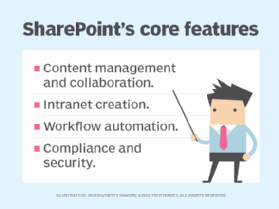
Getty Images/iStockphoto
An overview of Microsoft SharePoint
Microsoft offers on-premises and cloud versions of SharePoint to help organizations manage content. Core capabilities include collaboration, automation and data protection.
Organizations use Microsoft SharePoint to manage business content like financial transactions, training materials and marketing content.
Microsoft released its first version of SharePoint -- an enterprise content management system -- in 2001. Since then, the company has released many subsequent versions of the tool, including a cloud-based option called SharePoint Online. SharePoint's core features include content management and collaboration, intranet creation, workflow automation and compliance.
To effectively implement SharePoint, explore this overview of the tool's core features and deployment options.
What is Microsoft SharePoint?
SharePoint is a web-based content management system that lets organizations store, share and collaborate on various types of content, such as documents, images and multimedia files. The tool natively integrates with other Microsoft 365 apps and offers automation capabilities to help users streamline workflows. Organizations can choose on-premises or cloud deployment options, depending on their requirements.
Core SharePoint features
SharePoint offers various features, such as content management and automation, to help organizations streamline business operations.
Content management and collaboration
SharePoint can serve as a central repository in which organizations can store and manage all business content. The tool lets admins create websites for different departments, topics and teams, which can then help authorized users find and collaborate on important documents.
For example, marketing leaders could create a SharePoint team site that contains a document library where small groups of workers can upload and collaborate on assignments. These libraries offer version control features, which can track changes and save past document versions as users collaborate. Users can also lock files as they edit to ensure they don't overwrite other users' edits.
Additionally, SharePoint natively integrates with Microsoft Teams to further support collaboration. If someone creates a group in Teams, the tool automatically creates a SharePoint site for that group, because Teams uses SharePoint as its storage backend. Therefore, employees can use SharePoint to store, access and edit documents directly from their Teams interface, which can improve collaboration.
Intranet creation
SharePoint lets users create communication sites to build intranets, which are private websites used to share corporate communications with large internal audiences.

Intranets offer employees a place to find company-wide news and important updates. For example, an HR department might create a communication site to inform employees about changes to company policies or benefits packages.
Users can also create enterprise wiki sites, which are collaborative knowledge bases, and link to them on their communication sites. Enterprise wiki sites can help employees find important knowledge and reduce the number of help inquiries sent to HR, legal or IT teams.
Additionally, business leaders, such as CEOs or departmental heads, could create communication sites to share blogs posts with a wide audience. Admins can embed Viva Engage -- Microsoft's social media platform -- into these blog sites to encourage employee engagement and help leaders solicit feedback on new strategies and initiatives.
Workflow automation
Like many modern content management systems, SharePoint offers automation to help users streamline workflows. The tool natively integrates with Microsoft Power Automate, a low-code/no-code tool that connects different apps, to let casual business users design automation processes. Common uses for SharePoint and Power Automate include trigger-based email notifications and automated approval processes.
For example, marketers might use Power Automate to streamline approvals for client proposals. Marketers upload proposals to a folder titled Pre-approved, and the tool can automatically send an email notification to a supervisor for review. If the supervisor approves the proposal, Power Automate can then notify the sender and move the document to a folder titled Approved. Process automations like this can save employees' time and improve their efficiency.
Compliance and security
SharePoint offers native data governance capabilities to help users comply with government regulations, such as the Sarbanes-Oxley Act and GDPR. For instance, organizations can create records retention schedules in the Microsoft Purview portal -- formerly Microsoft 365 Compliance -- and apply them to SharePoint at the site or document level.
The tool also offers security features, such as multifactor authentication (MFA), to protect users' content from outside threats. MFA requires users to authenticate their identities in at least two ways, such as a password and text verification, before they can access the system. This feature can protect an organization's data in the case of compromised password credentials.
Additionally, SharePoint integrates with Microsoft Defender for Cloud, a security add-on that can detect and prevent cyber attacks. Defender's anti-malware capabilities can scan documents as users add them to SharePoint to guard against viruses and ransomware.
Deployment options
SharePoint users can choose cloud, on-premises or hybrid deployment options depending on their business requirements.
Cloud
Microsoft offers SharePoint as a cloud-based SaaS product in which users pay a monthly or annual subscription fee to access the software. Organizations that choose this option don't have to invest in server licenses, hardware or maintenance costs because Microsoft hosts the software on its own servers.
Cloud deployment lets organizations scale their operations and support remote work, as it lets authorized users access SharePoint from anywhere with an internet connection. However, this option offers limited customization and data privacy options because users don't own the servers.
On premises
Organizations that want full control over their data and advanced compliance capabilities can choose an on-premises SharePoint deployment. This option requires organizations to host SharePoint on their own servers.
An on-premises deployment can save organizations money in the long term. Yet it requires high up-front costs and IT staff to maintain and update the software and hardware. Organizations in heavily regulated industries, such as finance and government, might choose an on-premises deployment because it offers more control over data security.
Hybrid
Some SharePoint users choose a hybrid deployment model, which combines cloud and on-premises models. A hybrid model lets users gradually transition their content management strategies from on premises to the cloud instead of all at once. Organizations might also use a hybrid deployment to store highly sensitive data on-premises while managing less-sensitive data in the cloud.
Overall, this approach lets organizations combine the benefits of cloud, such as reduced installation and maintenance costs, with those of on-premises storage, such as increased security. However, this option still requires higher up-front and maintenance costs than a standard cloud deployment.
SharePoint versions
The most recent versions of SharePoint, named SharePoint Online and SharePoint 2019, offer similar functionality but have different deployment and pricing options.
SharePoint Online
SharePoint Online is Microsoft's cloud-based offering, which organizations can purchase through monthly or annual subscriptions. Microsoft sells SharePoint Online as a standalone product, but organizations commonly purchase it as part of a Microsoft 365 subscription.
SharePoint Online integrates with SharePoint Premium, an AI add-on formerly known as SharePoint Syntex. SharePoint Premium's features include data extraction capabilities that can automatically pull vendor names and addresses from invoices as well as speed up workflows.
Pricing for the standalone SharePoint Online subscription is $5 per user monthly. The Microsoft 365 options range from $6 per user monthly for the Business Basic plan to $57 per user monthly for the E5 plan.
SharePoint 2019
SharePoint 2019 is Microsoft's latest on-premises SharePoint offering, which grants users a high level of control over their data. To use SharePoint 2019, organizations must purchase their own SharePoint farms -- groups of servers that host the software -- and perform routine maintenance themselves.
This option requires users to purchase a license for each server and a client access license (CAL) for each user. Server licenses typically cost between $4,000 and $8,000 each, whereas CALs typically cost anywhere from $100 to $300 per user.
SharePoint's content management features, along with its native integration with other Microsoft products, can help organizations streamline workflows and protect data across teams. Content management and IT leaders that plan to implement SharePoint should consider their organizations' customization and security requirements to choose the right deployment option for their needs.
Tim Murphy is associate site editor for TechTarget's Customer Experience and Content Management sites.







